 |
 |
 |
| |
ACH-2928: A NOVEL HIGHLY POTENT HCV NS5A INHIBITOR WITH FAVORABLE PRECLINICAL CHARACTERISTICS
|
| |
| |
Reported by Jules Levin EASL 2011 Berlin Germany March 30-Apr 2
Mingjun Huang, Guangwei Yang, Dharaben Patel, Yongsen Zhao, Joanne Fabrycki, Christopher Marlor, Jose Rivera, Kathe Stauber, Venkat Gadhachanda, Jason Wiles, Akihiro Hashimoto, Dawei Chen, Quiping Wang, Godwin Pais, Xiangzhu Wang, Milind Deshpande and Avinash Phadke
AUTHOR CONCLUSIONS
ACH-2928 is a highly potent NS5A inhibitor against genotype 1 replicons and its potency is only moderately affected by human serum.
The high potency of ACH-2928 is retained against gentype-1 natural variants (EC 50 <17 pM) as well as genotypes 2, 3, 4, 5 and 6 strains tested (EC50 <200 pM).
ACH-2928 is a selective inhibitor against HCV.
ACH-2928 shows low potential for off-target activities and drug-drug interactions.
ACH-2928 shows favorable ADME properties for its indication as a combination therapy for treatment of chronic hepatitis C virus (HCV) infection.
Based on these positive results and its good safety profile, ACH-2928 has been selected for clinical development for treatment of hepatitis-C .
ABSTRACT
Background - Hepatitis C virus (HCV) NS5A has emerged as an important target for treatment of HCV. ACH-2928 is a potent, pan-genotypic NS5A inhibitor. ACH-2928 has demonstrated synergistic activity in combination with ACH-1625, a HCV NS3 protease inhibitor (Huang et al AASLD 2010). Herein, we describe antiviral activity, specificity, safety, and pharmacokinetic characteristics of ACH-2928 that support once-daily dosing.
Method Optimization of NS5A inhibitors was achieved through evaluation of potency in cell lines harboring genotype-1a and 1b HCV replicon. Various chimeric HCV replicons were constructed to assess the anti-HCV spectrum of lead inhibitors. ADME characteristics, pharmacokinetic properties, and off-target activities were examined by standard procedures.
Results - ACH-2928 displayed picomolar potency in cell lines harboring a laboratory strain 1b and 1a replicon. High potency was retained against a panel of chimeric replicons carrying NS5A from genotype-1a and 1b-HCV infected patients with average EC50 values of 13 pM and 1.9 pM for genotype-1a and 1b, respectively. Potency comparable to genotype 1a was observed for genotype 2a, 4a and 5a chimeric replicon (EC50 < 14 pM). Potency against genotypes 6a and 3a chimeric replicon was 48 pM and 103 pM, respectively. The effect of human serum proteins on the potency of ACH-2928 was moderate (~7 fold in the presence of 40% human serum). ACH-2928 showed no activity against other mammalian viruses tested. ACH-2928 displayed low cellular toxicity and off target activity against a panel of mammalian ligands' binding and mammalian enzymes. ACH-2928 did not inhibit major CYP isoforms. Oral bioavailability in the rat and dog ranged from 20% - 40%.
Conclusion
ACH-2928 is a potent NS5A inhibitor against genotypes 1-6. It shows low potential for off-target activity and displays pharmacokinetics that support once daily dosing. It has a profound effect in vitro in preventing the emergence of resistant variants when combined with ACH-1625, an NS3 protease inhibitor in phase 2 clinical trials. These characteristics support clinical evaluation of ACH-2928 in combination with ACH-1625 for once daily treatment of hepatitis C patients.

Method
Potency was determined in Huh-luc/neo cell line (GT 1b,Strain Con-1) by measuring reporter luciferase activity with luciferase enzyme assay 3 days post addition of the inhibitor. Cellular toxicity was determined by measuring cell viability with CellTiter 96® AQueous One Solution kit.

Method
Potency was determined by measuring HCV replicon RNA with dot blot assay 3 days post addition of the inhibitor
ACH-2928 possesses highly potent activity against both genotype-1a and 1b HCV replicons
ACH-2928 showed no cellular toxicity up to 10 μM, highest concentration tested, resulting in as selectivity index of > 3.7 x 10
The effect of humans serum on the potency of ACH-2928 is moderate.
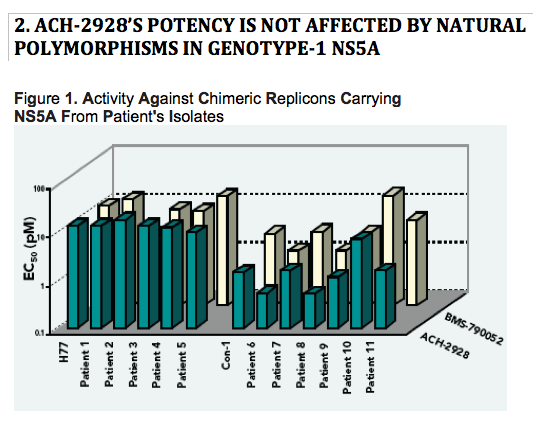
Method
Potency was determined in transient replicating chimeric replicons by measuring reporter luciferase activity with luciferase enzyme assay 3 days post addition of the inhibitor. These chimeric replicons were constructed by replacing the NS5A in genotype-1b/Con-1 transient replicating replicon with that from patient isolates.
ACH-2928 displays an average EC 50 of 13 pM (range 9.6 - 17 pM) against genotype-1a isolates and an average EC50 of 1.9 pM (range 0.5 - 6.8 pM) against genotype-1b isolates.
BMS-790052 displays a similar potency as ACH-2928 against genotype-1a isolates and a weaker potency than ACH-2928 against genotype-1b isolates.
3. ACH-2928 RETAINS HIGH POTENCY AGAINST
NON-GENOTYPE-1 HCV
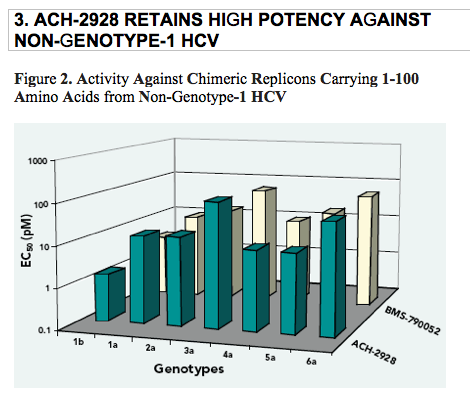
Method
Potency was determined in transient replicating chimeric repli¬cons by measuring reporter luciferase activity with luciferase enzyme assay 3 days post addition of the inhibitor. These chimeric replicons were constructed by replacing 1-100 amino acids of the NS5A in genotype-1b/Con-1 transient replicating replicon with that from a strain of none-genotype-1 HCV.
All chimeric replicons are as susceptible as genotype-1 (EC50 <25 pM) to both ACH-2928 and BMS-790052, except genotype 6a and 3a chimeric replicons.
The EC 50 values of ACH-2928 against genotypes 6a and 3a were 48 and 103 pM, respectively. Similar values for EC50 against genotypes 6a and 3a were also observed with BMS-790052.
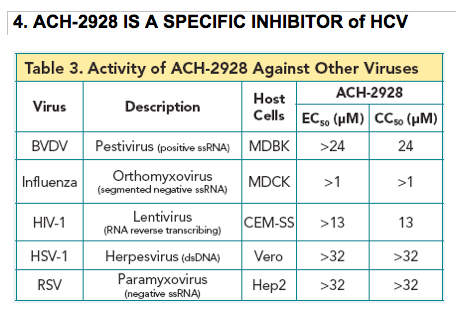
Method
The antiviral activity was tested against BVDV, HIV-1, HSV-1, RSV and influenza in their respective cellular assay systems. The growth of these viruses in their respective host cells induces CPE (cytopathic effect). The antiviral activity is measured by the cell viability as a consequence of inhibition of CPE by inhibitor with CellTiter 96® AQueous One Solution kit.
ACH-2928 displays no activity against the viruses tested, suggesting that ACH-2928 is specific for HCV.
In addition, ACH-2928 was evaluated for its pharmacological receptor binding potential in vitro. ACH-2928 exhibited clinically insignificant receptor binding potential in vitro.
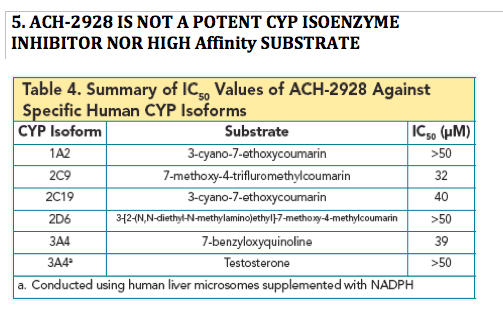
Method
ACH-2928 was screened against recombinant CYP with fluorescent substrate. Selected isoforms were assessed further in pooled human liver microsomes (HLM) with isoform-specific substrates.
ACH-2928 metabolic stability was determined by incubation with hepatic microsomes or hepatocytes followed by LC/MS-MS quantitation. Data were fitted to exponential decay to derive t·.
ACH-2928 shows high metabolic stability in human and nonclinical species liver microsomes and hepatocytes.
ACH-2928 is not a potent inhibitor of human CYP enzymes.
ACH-2928 is not a high affinity substrate for human CYP enzymes (data not shown).
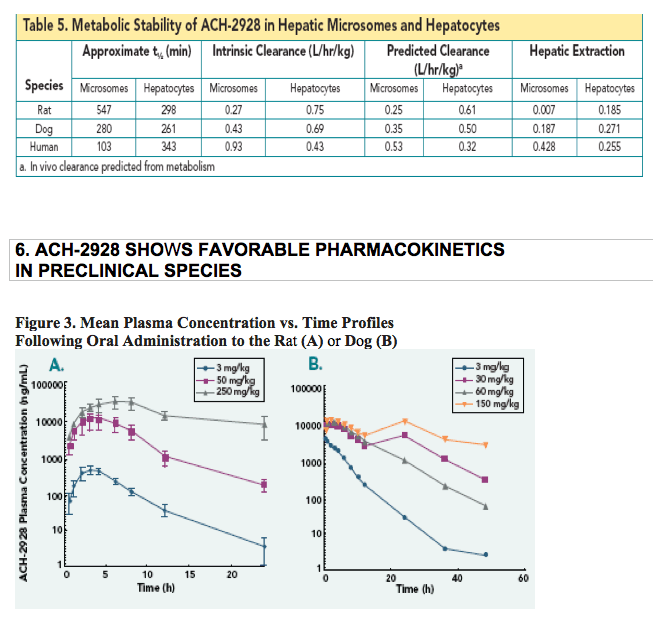
Method
ACH-2928 was dosed to SD rats (A) or Beagle dogs (B) by oral gavage at the doses indicated. The plasma concentration was measured by LC/MS-MS. Non-compartmental pharmacokinetic analysis was performed using WinNonlinTM Professional.
TThe pharmacokinetic profile of ACH-2928 in the rat and dog was characterized by low clearance such that plasma ACH-2928 concentrations were detectable out to at least 48 hr post-dose.
220 - 40 % oral bioavailability was achieved in the rat and dog.
FFollowing multiple dose administration, ≤2-fold accumulation was seen in the rat and dog.
Gender differences in the pharmacokinetics of ACH-2928 were not observed.
|
| |
|
 |
 |
|
|